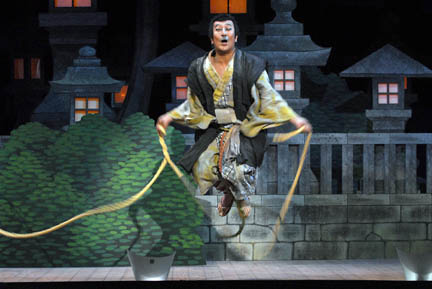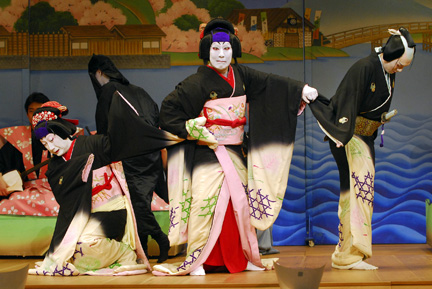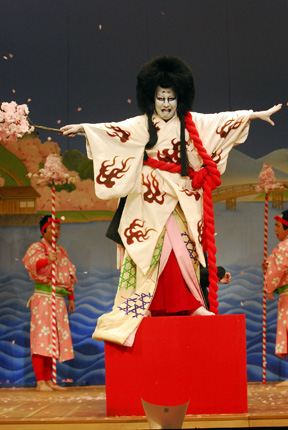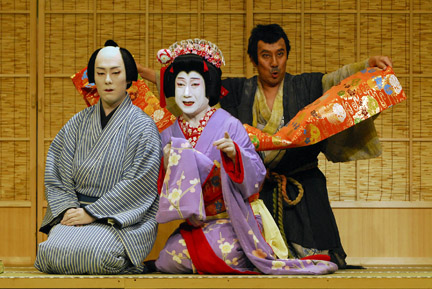"Hokaibo"
Heisei Nakamura-za
Avery Fisher Hall
Lincoln Center Festival
New York, NY
July 17—22, 2007
by Gay Morris
copyright © 2007 by Gay Morris
 How far can a classical form be pushed before it becomes something else? That was a question Vaslav Nijinsky faced when he created "Le Sacre du Printemps." Had he transformed the ballet vocabulary to the degree that it was no longer ballet? Directors who drastically alter Shakespeare’s works grapple with a similar, although perhaps less radical, problem. Kushida Kazuyoshi, one of Japan’s best known directors of contemporary plays, and Nakamura Kanzaburo XVIII, a well-known Kabuki actor, have also dealt with this issue while working together to give a contemporary inflection to Kabuki theater.
How far can a classical form be pushed before it becomes something else? That was a question Vaslav Nijinsky faced when he created "Le Sacre du Printemps." Had he transformed the ballet vocabulary to the degree that it was no longer ballet? Directors who drastically alter Shakespeare’s works grapple with a similar, although perhaps less radical, problem. Kushida Kazuyoshi, one of Japan’s best known directors of contemporary plays, and Nakamura Kanzaburo XVIII, a well-known Kabuki actor, have also dealt with this issue while working together to give a contemporary inflection to Kabuki theater.
The two men brought a production of “Sumidagawa — Gonichi No Omokage,” better known as “Hokaibo,” to Avery Fisher Hall this past week as part of the Lincoln Center Festival. Nakamura is the head of the Tokyo based Kabuki company, Heisei Nakamura-za. Although it is unusual for an outside director to work with a Kabuki company, Nakamura welcomed the partnership with Kushida. It was the second trip to the festival for Nakamura-za, having appeared in 2004, also in a production directed by Kushida.
 “Hokaibo” was billed as a rare example of Kabuki comedy, but although it has many comic moments, it also contains as much violence, heroism and romance as more typical examples of the form. It starred Nakamura as the rogue Hokaibo, who in this instance is disguising himself as a priest. The complex plot involves a precious scroll that Matsuwaka, a young noble, has lost, leading to the downfall of his family. An elderly pawnshop owner and his daughter, Okumi, are attempting to help Matsuwaka find the scroll. They discover that Kanjuro, a dealer in art objects, has it and they bargain for its return. However, the repulsive Kanjuro demands money and the hand of Okumi, who already has fallen in love with Matsuwaka. Hokaibo becomes involved in trying to obtain the scroll, while at the same time Matsuwaka is pursued by a princess to whom he had been engaged as a child. Hokaibo eventually goes on a murderous spree in order to make the scroll his own. Among others, he kills Kanjuro, Okumi’s father, and the princess. He is, himself, finally killed by the story’s real hero, Jinzaburo, an antique dealer and friend of Okumi’s father. Jinzaburo also secures the lost scroll from the hands of Hokaibo and returns it to its rightful owner. However, we are not done with Hokaibo. In the final third act, he reappears as a vengeful ghost, bent on ruining the happiness of Matsuwaka and Okumi. He poses as a false Okumi and as the spirit of the dead princess in an attempt to confuse Matsuwaka and the other characters. When he doesn’t succeed, he pours out his wrath until Jinzaburo, with the help of the magical scroll, drives him away, “writhing in pain.”
“Hokaibo” was billed as a rare example of Kabuki comedy, but although it has many comic moments, it also contains as much violence, heroism and romance as more typical examples of the form. It starred Nakamura as the rogue Hokaibo, who in this instance is disguising himself as a priest. The complex plot involves a precious scroll that Matsuwaka, a young noble, has lost, leading to the downfall of his family. An elderly pawnshop owner and his daughter, Okumi, are attempting to help Matsuwaka find the scroll. They discover that Kanjuro, a dealer in art objects, has it and they bargain for its return. However, the repulsive Kanjuro demands money and the hand of Okumi, who already has fallen in love with Matsuwaka. Hokaibo becomes involved in trying to obtain the scroll, while at the same time Matsuwaka is pursued by a princess to whom he had been engaged as a child. Hokaibo eventually goes on a murderous spree in order to make the scroll his own. Among others, he kills Kanjuro, Okumi’s father, and the princess. He is, himself, finally killed by the story’s real hero, Jinzaburo, an antique dealer and friend of Okumi’s father. Jinzaburo also secures the lost scroll from the hands of Hokaibo and returns it to its rightful owner. However, we are not done with Hokaibo. In the final third act, he reappears as a vengeful ghost, bent on ruining the happiness of Matsuwaka and Okumi. He poses as a false Okumi and as the spirit of the dead princess in an attempt to confuse Matsuwaka and the other characters. When he doesn’t succeed, he pours out his wrath until Jinzaburo, with the help of the magical scroll, drives him away, “writhing in pain.”
 This production of “Hokaibo” bears the subtitle “(Kushida’s World),” as if to emphasize the contemporary approach the director would take. However, this does not mean that we were given a Kabuki production in modern dress or one sporting technological fireworks. The updating tended to be more nuanced. For example, the black-clad kurogo, who change props and arrange the actors’ costumes, and who, as far as the play is concerned, are invisible, were given a more active role. They communicated with the actors from time to time, although they did not speak. There were also narrated preambles to each act, in which the kurago introduced the actors with pantomimed gestures. This enlargement of the kurogo role may seem of minor importance, but in the feudal world of Kabuki, it is a little like freeing the serfs.
This production of “Hokaibo” bears the subtitle “(Kushida’s World),” as if to emphasize the contemporary approach the director would take. However, this does not mean that we were given a Kabuki production in modern dress or one sporting technological fireworks. The updating tended to be more nuanced. For example, the black-clad kurogo, who change props and arrange the actors’ costumes, and who, as far as the play is concerned, are invisible, were given a more active role. They communicated with the actors from time to time, although they did not speak. There were also narrated preambles to each act, in which the kurago introduced the actors with pantomimed gestures. This enlargement of the kurogo role may seem of minor importance, but in the feudal world of Kabuki, it is a little like freeing the serfs.
The production’s major innovations, though, were in the way in which the humor was rendered. To begin with, Kushida gave the play a bawdiness that would be hard to imagine on the stage of the Kabuki-za, Tokyo’s shrine to traditional Kabuki theater. Kanjuro’s lasciviousness, for instance, was expressed by an uncontrollable, dancing bulge beneath his kimono. Far more radical was Kushida’s decision to give Nakamura many asides to the audience in English. “You up there with the cheap tickets,” he at one point called out to the back of the balcony. At another moment, when Hokaibo digs a grave for one of his victims and finds a skull, Nakamura made a remark about Yorick and then putted the object back into the hole like a golf ball.
Kushida also commented humorously on aspects of Kabuki, most apparent in his handling of the character of the princess. Being of noble birth, she is extremely refined, her gestures drawn out and ritualized, in contrast to the more plebian characters. Every time she hears bad news, Kushida has her withdraw a suicide knife from her robe, a reference to seppuku, the ritual suicide common in Kabuki. This in itself would be funny, because her actions are far more numerous than what would ever take place in a traditional Kabuki performance. However, in this case there is an additional joke, because her movements are so agonizingly controlled that by the time she has unwrapped the knife the stage action has galloped far beyond her. Impatiently watching yet another of the princess’s stately crossings of the stage, Nakamura exclaimed in one of his asides, “why is she so damned slow!”
 Although Hokaibo is anything but the hero of the play, and not even the major character in terms of most of the action, he is nonetheless the center of attention. Nakamura was a whirlwind of energy, sweating as he tore from one scene to another and delivering the English asides with gusto. Then there was the last act, which calls for a complete change in Hokaibo’s character. Now all the previous humor vanishes as he becomes a vengeful ghost. Hokaibo’s role in this act is also almost exclusively communicated through dance. Nakamura was unnervingly grotesque in his impersonation of Okumi. He is a stocky man, and dressed as a female (onnagata), he made his appearance both gross and at the same time queasily feminine. His gestures in Okumi’s dance, although delicate, had a slightly abrupt quality, while his demure facial expressions periodically disintegrated into leers and snarls. This overall movement perfectly captured a sense of the ghost’s hatefulness. This act also calls for a great deal of virtuosic movement on the part of the ghost as he attempts to show his rage and power. Nakamura, who is probably in his fifties, managed the ghost’s athletic demands fairly well, at one point even somersaulting off a platform on which he had been dancing.
Although Hokaibo is anything but the hero of the play, and not even the major character in terms of most of the action, he is nonetheless the center of attention. Nakamura was a whirlwind of energy, sweating as he tore from one scene to another and delivering the English asides with gusto. Then there was the last act, which calls for a complete change in Hokaibo’s character. Now all the previous humor vanishes as he becomes a vengeful ghost. Hokaibo’s role in this act is also almost exclusively communicated through dance. Nakamura was unnervingly grotesque in his impersonation of Okumi. He is a stocky man, and dressed as a female (onnagata), he made his appearance both gross and at the same time queasily feminine. His gestures in Okumi’s dance, although delicate, had a slightly abrupt quality, while his demure facial expressions periodically disintegrated into leers and snarls. This overall movement perfectly captured a sense of the ghost’s hatefulness. This act also calls for a great deal of virtuosic movement on the part of the ghost as he attempts to show his rage and power. Nakamura, who is probably in his fifties, managed the ghost’s athletic demands fairly well, at one point even somersaulting off a platform on which he had been dancing.
However, if Nakamura was the star of the show, the other actors of his company were also impressive, particularly Nakamura Hashinosuke as Jinzaburo, who saves the day repeatedly during the course of the play, and Sasano Takashi as Kanjuro, the vulgar but irrepressible art dealer who wants Okumi for his bride. One should mention, too, the onnagata performances of Nakamura Senjaku as Okumi and Nakamura Shichinosuke as the princess.
In the final analysis, one must ask how Kushida’s innovations worked in relation to the spirit of Kabuki. Certainly they did not destroy the form, which can be seen in its more traditional garb at the Kabuki-za and other theaters in Japan. Undoubtedly some of the insider humor was lost on us foreigners, unfamiliar with the intricacies of Kabuki. However, the English asides worked for Americans, drawing us closer to the action. If they were exaggerations created for western audiences, we can accept them as such because they were in English. For what it’s worth, I noticed that the Japanese members of the audience were laughing, too. Finally, how a production is received has much to do with the setting. Perhaps on the stage of the Kabuki-za, Kushida’s production would have people rioting, but on the stage of Avery Fisher Hall at the height of summer, it provided a fine evening’s entertainment.
Photos are all by Stephanie Berger.
Volume 5, No. 29
July 23, 2007
copyright ©2007 by Gay Morris
www.danceviewtimes.com